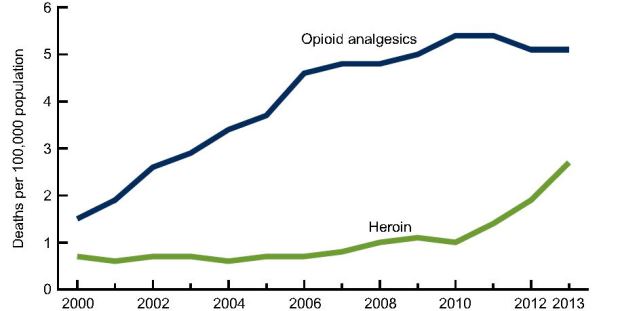
Heroin Death Rate Nearly Quadrupled from 2000-2013, CDC Reports
The age-adjusted rate for drug overdose deaths involving heroin jumped from 0.7 deaths per 100,000 in 2000 to 2.7 deaths per 100,000 in 2013, according to a new CDC report, and most of the increase occurred after 2010.
Several alarming statistics are contained in a new CDC report that says the rate of heroin overdose deaths among Americans nearly quadrupled between 2000 and 2013, rising from 0.7 deaths per 100,000 in 2000 to 2.7 deaths per 100,000 in 2013. The report, "Drug-poisoning Deaths Involving Heroin: United States, 2000–2013," has been published by CDC's National Center for Health Statistics. It found that:
- Deaths from heroin overdose increased among all age and race and ethnicity groups.
- All regions of the country saw an increase in heroin overdose deaths, with the largest increase in the Midwest.
- In 2013, the number of heroin-related drug-poisoning deaths for men (6,525 deaths) was nearly four times that for women (1,732 deaths).
In 2000, non-Hispanic black persons aged 45–64 had the highest rate for drug-poisoning deaths involving heroin (2.0 per 100,000), but in 2013, non- Hispanic white persons aged 18–44 had the highest rate (7.0 per 100,000), the study's authors reported. They said drug overdose is the number one cause of injury-related death in the United States, with 43,982 deaths occurring in 2013. "While much attention has been given to deaths involving opioid analgesics, in recent years there has been a steady increase in the number of drug-poisoning deaths involving heroin. A recent study using data from 28 states reported that the death rate for heroin overdose doubled from 2010 through 2012," they wrote.
And adults aged 25-44 had the highest rate for drug-poisoning deaths involving heroin. From 2000 through 2010, the average annual increase in the rates was 10 percent for adults aged 18–24, 5 percent for those aged 25–44, and 4 percent for those aged 45–64, but from 2010 through 2013, the death rate for adults aged 18–24 increased 2.3-fold (from 1.7 to 3.9 per 100,000), for those aged 25–44 the rate increased 2.8-fold (from 1.9 to 5.4), and for those aged 45–64 the rate increased 2.7-fold (from 1.1 to 3.0).